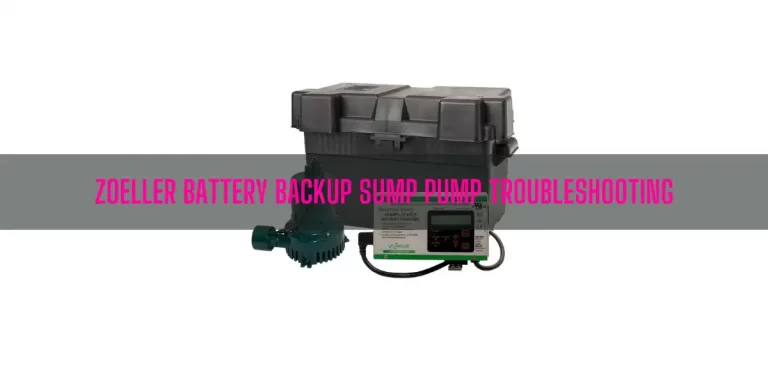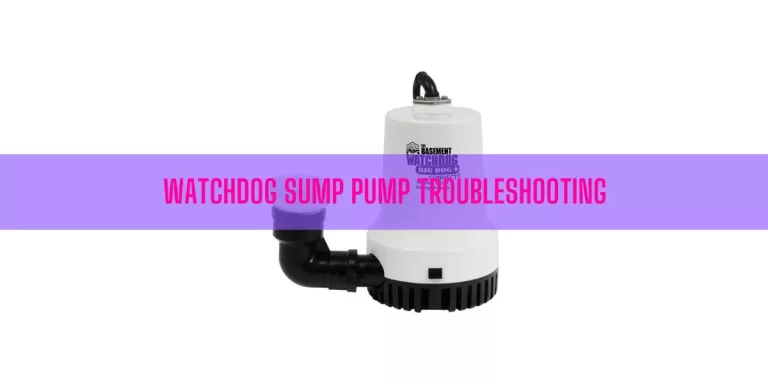Wayne Battery Backup Sump Pump Troubleshooting
This is a complete guide on Wayne Battery Backup Sump Pump Troubleshooting. From this article, what you are going to discover:
- 5 common problems of Wayne Battery Backup Sump Pump
- How To Reset Wayne Battery Backup Sump Pump?
- How To Install Wayne Battery Backup Sump Pump?
Without further ado, let’s dive in.
Table of Contents
- Wayne Battery Backup Sump Pump Troubleshooting [5 Problems & Solutions]
- How To Reset Battery Backup Sump Pump?
- How To Install Wayne Battery Backup Sump Pump?
- End-Note
Wayne Battery Backup Sump Pump Troubleshooting [5 Problems & Solutions]
Like every electric appliance, this battery backup sump pump from Wayne will also start malfunctioning over time. And this chapter will help you find the remedy to bring the unit into working condition.
1. Pump Won’t Start or Run
You attach a garden hose to the discharge, plug the Wayne battery backup pump into the power outlet, and notice it won’t start. Generally, your pump won’t come on if:
- The wire connections are not secure and tight
- Low or defective battery
- Float switch gets stuck
- A blown out fuse
- Battery voltage goes the below threshold, motor locked out
How To Fix:
To begin with, check every wire connection and connector. If they come loose, tighten up the wire connection.
Next, take a look at the battery and ensure it’s full of charge. If needed, recharge the battery to bring the pump into working condition. Don’t hesitate to replace the battery if it goes bad or the pump won’t come on after charging the battery fully.
Thirdly, a stuck float switch is another culprit that can throw a wrench into working. The pump won’t actuate if the switch is not moving freely with the rise of the water. Generally, the switch gets jammed by debris or corrosion.
Just unscrew the float switch and free up the blockage or debris from it. Replace the switch if it won’t move after cleaning the float switch.
The next caveat would be the blown out fuse if the pump won’t trigger after cleaning or replacing the float switch. To inspect the fuse, pull the transformer from the wall outlet and remove it. Now, take your eyes at the internal fuse located inside the control box. If the fuse gets defective, replace it with a 20 amp automotive type fuse.
And lastly, the pump won’t start if the motor locks up when its battery voltage reaches the lowest threshold like- your phone turns off when the battery goes to 0%.
The solution to this issue is simple as you charge up your phone. Just wait for the battery to recharge.
2. Motor Hums But Won’t Run
You plug your battery backup sump pump into the outlet and its motor starts making a humming noise- seems it will soon come on. But the heck is- the motor or pump operation is stuck up to the humming- not start pumping water.
If this is the issue you are going through with your battery backup sump pump, I bet the culprit is the battery itself. Due to a low or defective battery, the pump will not get enough punch to activate or start the motor.
To resolve this problem, the wise move will be- replacement of the battery.
Several reasons like a restricted vent hole, clogged check valve, and defective impeller are also responsible for the pump to make a high-pitch or humming noise.
However, the pump will come on despite making a noise in this case. Indeed, it’s a bit different compared to the humming noise- whose primary source is a low or defective battery.
3. Pump Runs But It Pumps Very Little or No Water
It’s another common sump pump issue most homeowners complain about. This problem occurs due to:
- A missing or improperly installed check valve
- Restrictions in the discharge pipe
- Discharge length or height exceeds the capacity of the pump
- Low or defective battery
How To Fix:
First off, verify the check valve your plumber installed between the primary pump discharge and the backup sump pump is functioning properly. If not, call a certified plumber to have the check valve installed professionally.
On the other hand, if you don’t install a check valve, get one immediately and assemble it between the primary pump discharge and the backup system.
Secondly, inspect the discharge pipe for restriction and release the blockage if needed.
Thirdly, ensure the discharge length or height doesn’t exceed the capacity of the pump. The maximum discharge height for Wayne sump pump is 25 ft. If the height exceeds this limit, lower the discharge to let the pump move water like a charm.
And lastly, replace the battery if it goes bad or it’s low on charge.
4. Pump Cycles Too Frequently
Too frequent pump cycles bring ultimate damage to the pump. This problem will actually happen if there is a problem with the check valve.
How To Fix:
I highly recommend you to call a professional to check the condition of the check valve. For better pumping experience, install a new check valve between the primary pump discharge and the backup system.
5. Power Failure Light Is On But AC Power Is Available
If the power failure light is on but getting AC power, I bet one of the following things are at fault:
- Defective transformer
- Transformer connection comes loose
- Circuit breaker or the fuse gets blown out
How To Fix:
Replace the transformer if it’s at fault. Secondly, check the A/C plug and the transformer connections under the lid are secure and tight.
Also, don’t forget to check the circuit breaker for the backup sump pump. If it gets tripped, just flip it up. Next, take a look at the fuse and ensure it doesn’t get tripped.
How To Reset Battery Backup Sump Pump?
Resetting the battery backup sump pump is quite easy. Just follow the below instructions and have the pump reset:
- Unplug the transformer from the electric outlet.
- Unplug the power cord of the backup sump pump from the power.
- Wait 30 seconds and restore the power to the sump pump.
- Don’t forget to plug the transformer into the electrical outlet.
- Once you restore the power to the sump pump, the unit will reset automatically.
How To Install Wayne Battery Backup Sump Pump?
If you are new in this task, this chapter will help you in installing the battery backup sump pump. Keep in mind; it may take several hours to install this sump pump.
Before installing this pump, ensure you turn off power to the main pump. The installation procedure I am going to describe will be applicable if you want to install this unit with a separate dedicated discharge line.
Here we go…
- Set the backup pump on a solid level surface in the sump pit. Never place this pump on a loose or sandy surface.
- This unit comes with a 1-½ in. NPT discharge. If you need a 1-¼ discharge pipe, you must need an adapter.
- Next, cut a 4 ft section of a 1-½ in. diameter rigid PVC pipe, cement that pipe to a threaded fitting. Then, cement pipe into pipe coupling. Lastly, attach the pipe section to the backup pump discharge adapter.
- Screw on to the pump discharge.
- Now, set the backup pump with the 4 ft section of pipe on a solid level surface in the sump pit- on an elevated surface.
- Finally, connect a required rubbed check valve to the top of the discharge pipe, which will allow the pump or check valve to be removed easily.
You can also take a look at the following installation diagram, which will make the installation easier.

End-Note
No matter what appliance you choose, it will go through some operational or functional problems at a particular juncture in its lifespan. And your Wayne Battery Backup Sump Pump is not an exception to that.
Fortunately, this troubleshooting guide broke down everything you need to know to resolve a specific sump pump issue.
What you need to do is just follow the instructions I mentioned above. Of course, don’t forget to disconnect it from the power source before attempting to perform any troubleshooting step. Otherwise, fatal electric shock could occur.

Eric Alvarez is the head of content on LilDutchUncle.Com. He is an HVAC guy based in El Paso, Texas, United States. He obtained his Bachelor of Science degree from the University Of Texas at El Paso. Years of experience in the HVAC field have taught him many lessons, not the least of which is that the value of quality and knowledge far exceeds any promised initial savings. He has a good standing reputation for superior skills in heating, air conditioning, hot water tanks, and indoor air quality systems.



![Zoeller Sump Pump Won’t Turn On [7 Easy Solutions]](https://lildutchuncle.com/wp-content/uploads/2023/02/Zoeller-Sump-Pump-Wont-Turn-On-768x384.webp)

![Zoeller Sump Pump Maintenance [Ultimate Guide]](https://lildutchuncle.com/wp-content/uploads/2023/03/Zoeller-Sump-Pump-Maintenance-768x384.webp)

